Green hills, dark castles, men in kilts – and above it all, the sound of bagpipes. Have you taken a fancy to Scotland and especially the Highlands and decided to travel there? I’ll tell you here which 20 attractions are particularly worth seeing on your first trip.
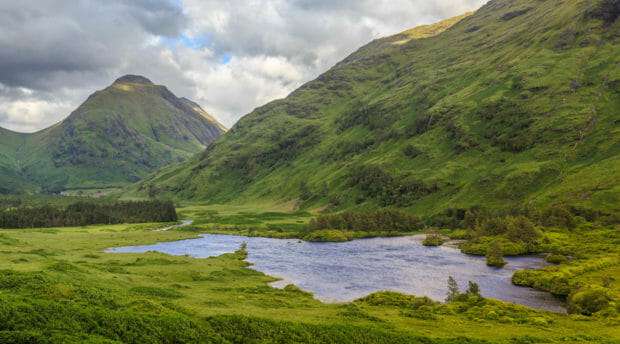
Famous names such as Loch Ness or the “Hogwarts Express” are certainly included in the top attractions. But you might also find one or two highlights in the list that are new and unknown to you.
Overall, I have tried to create a good mix of the most important attractions in Scotland. Where possible, however, I also mention alternatives that are just as beautiful, but are located elsewhere or are less visited.
The top attractions at a glance
- Loch Ness & Urquhart Castle
- Eilean Donan Castle
- Glenfinnan Viaduct and the “Hogwart’s Express”
- Culloden
- Old Man of Storr & Quiraing
- Edinburgh Castle
- Calanais
- Edradour Distillery
- Rosslyn Chapel
- Glen Coe
- National Museum
- Stirling Castle
- Ring of Brodgar
- Necropolis
- Dunnottar Castle
- Northern highlands (North Coast 500)
- Kelpies
- V&A Dundee
- Dunrobin Castle
- St Kilda
Scotland’s top 20 attractions on the map
Here now are the top 20 attractions in Scotland with descriptions and information.
1 | Loch Ness & Urquhart Castle
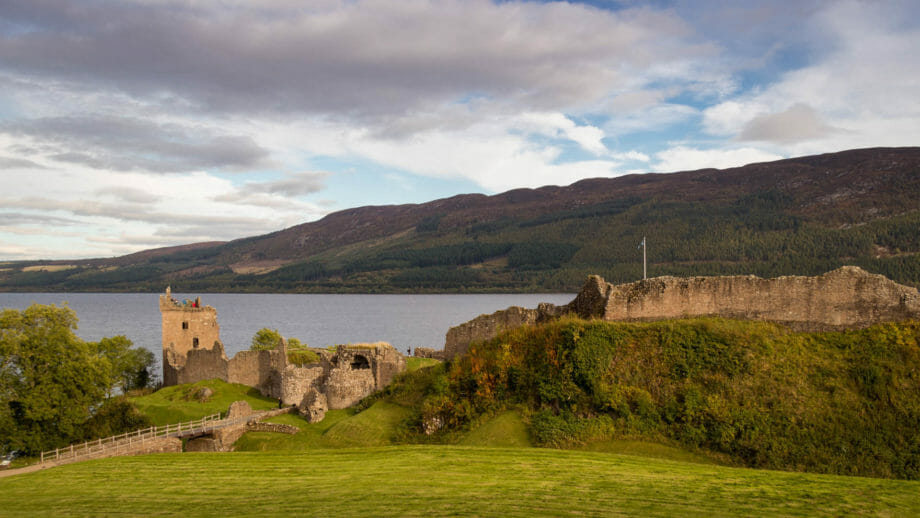
That’s why you have to see Loch Ness:
The name is legendary, the monster world-famous – travellers to Scotland simply must have visited this attraction. Urquhart Castle brings the appropriate flair to it.
More of it:
About 30 kilometres and half an hour’s drive away is the beautiful Glen Affric with Loch Affric. Scotland’s largest loch is Loch Lomond, which is also beautiful and immortalised in song.
Opening hours Urquhart: Apr-Sep 09:30-18:00 h, Oct 09:30-17:00 h, Nov-March 9:30-16:30 h
Admission: adults approx. £10, children approx. £6
Loch Ness exerts a special fascination on travellers to Scotland. On the one hand, of course, because of the legendary monster Nessi, who is said to be hiding in the huge lake. On the other hand, because the glaciers of the Ice Age have cut into the landscape in such a way that Loch Ness is up to 230 metres deep. Some seas are shallower! In terms of surface area, Loch Ness is only the second largest in Scotland. But thanks to its depth, it is the richest in water.
But a loch also lives from its shores. One of Scotland’s most famous castles is located here: Urquhart Castle. Although only a tower and a few walls remain, it exudes a wonderful charm against the backdrop of the lake. Moreover, its history is beautifully told in the castle’s visitor centre.
Loch Ness lies in the Great Glen, a majestic valley that runs through the Highlands from Inverness in the east to Fort William in the west. These two cities are connected by the Caledonian Canal. That is why there are old locks at each end of Loch Ness. Tip: In Fort Augustus, the hustle and bustle at the old locks can be observed particularly well.
2 | Eilean Donan Castle
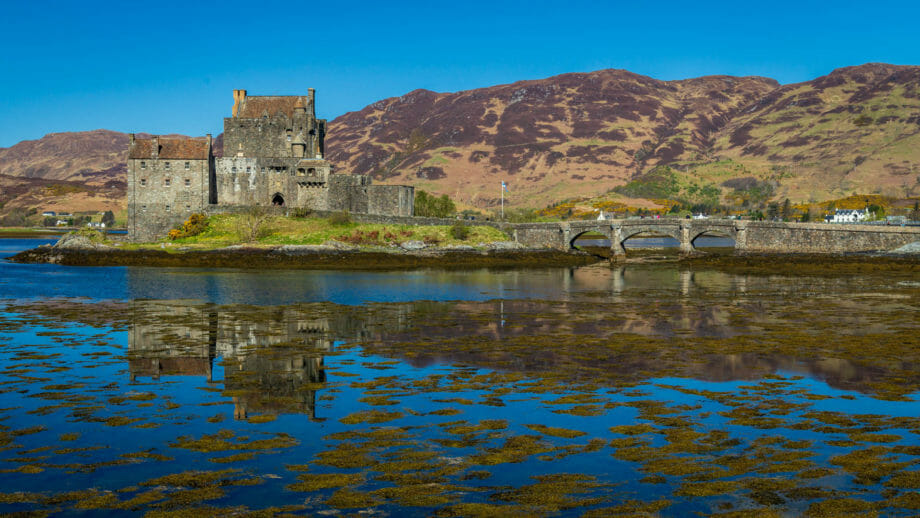
Why you must see Eilean Donan Castle:
It is THE Scottish showpiece castle, famous from numerous films. Washed by the sea and surrounded by the Highland hills, you have to cross the famous stone bridge to reach it. A sublime feeling!
More of it:
Caerlaverock Castle in the south of Scotland is a great triangular-shaped moated castle. Doune Castle near Stirling is a well-known film set with fantastic audio guides.
Opening hours: Daily between 10:00 and 18:00 in summer.
Admission: Adults £10, children £6
It is the most photographed castle in Scotland. Both by visitors and film-makers. Eilean Donan Castle has provided a worthy backdrop for a number of hit films – from the fantasy classic “Highlander” to the spy hit James Bond.
Eilean Donan means “Island of Donan”. This is because the castle was built on a small island in an inlet. To enter it, you have to cross the legendary stone bridge that, together with the mountains and the sea, makes the castle so photogenic.
Inside, there is also a lot to see: A guided tour will show you the highlights – such as the secret room from which you can look into the dining room.
The castle that stands here now, however, is only about 100 years old. That’s because English warships completely shot up Eilean Donan Castle in the wake of the Jacobite Rebellion of 1715. Only later was it rebuilt and the beautiful stone bridge added.
My tip: If you can, come to Eilean Donan Castle at night. You can’t get in then, but it is beautifully lit. Unique for special photos.
3 | Glenfinnan Viaduct and the “Hogwarts Express”
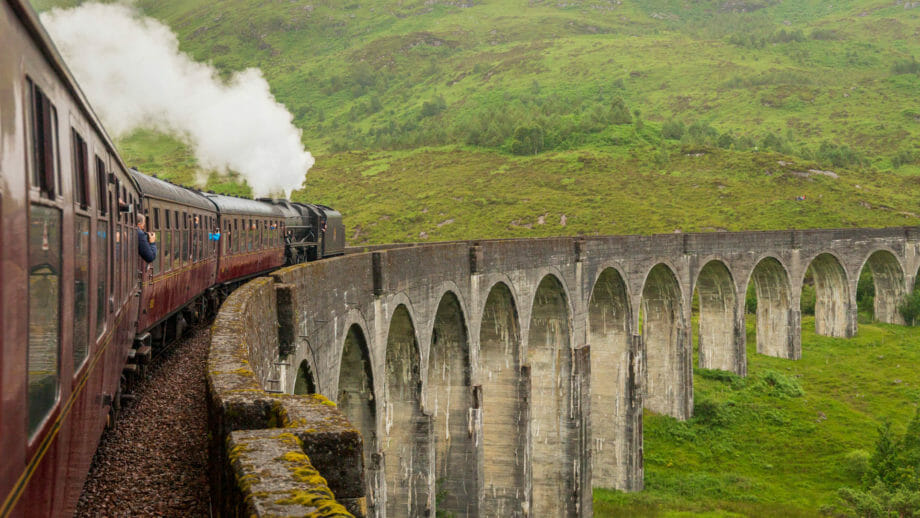
That’s why you have to see the Glenfinnan Viaduct:A world-famous railway bridge nestled into the flanks of a mountain massif. The Jacobite Steam Train, which became world famous as Harry Potter’s “Hogwarts Express”, runs over it.
More of it:
A great viaduct is the Culloden Viaduct near Nairn and the Clava Cairns. A great steam train experience is the Bo’ness & Kinneil Railway and its historic station near Edinburgh.
Departure: daily Apr-Oct mornings 10:15am, daily May-Sep afternoons 2:30pm.
Tickets: from £52 adult, £30 child return
Here the “Hogwarts Express” winds picturesquely over the curved bridge. And this is also where the “Great Lake” of Hogwarts lies. So the village of Glenfinnan is a magical attraction for Harry Potter fans.
But even if the wizard movies don’t interest you that much, the setting is still one of Scotland’s top attractions. For the railway bridge Glenfinnan Viaduct nestles semicircularly against the surrounding hillsides. And the loch – Loch Shiel – disappears on the horizon framed by a picturesque valley.
You can drive directly to Glenfinnan by car. Or you can drive yourself along here on the famous train. The Jacobite Steam Train (that’s the real name of the “Hogwarts Express”) departs twice a day from Fort William. Find out more here.
By the way, if you get a whiff of history in Glenfinnan, it’s because Charles Edward Stuart once gathered the clans on these hills to lead them in the Jacobite Rebellion against the British throne. This is commemorated by the Glenfinnan Monument in front of the lake.
What began here with the clans and Bonnie Prince Charlie eventually ended at the next sad attraction: the battlefield of Culloden.
4 | Culloden Battlefield
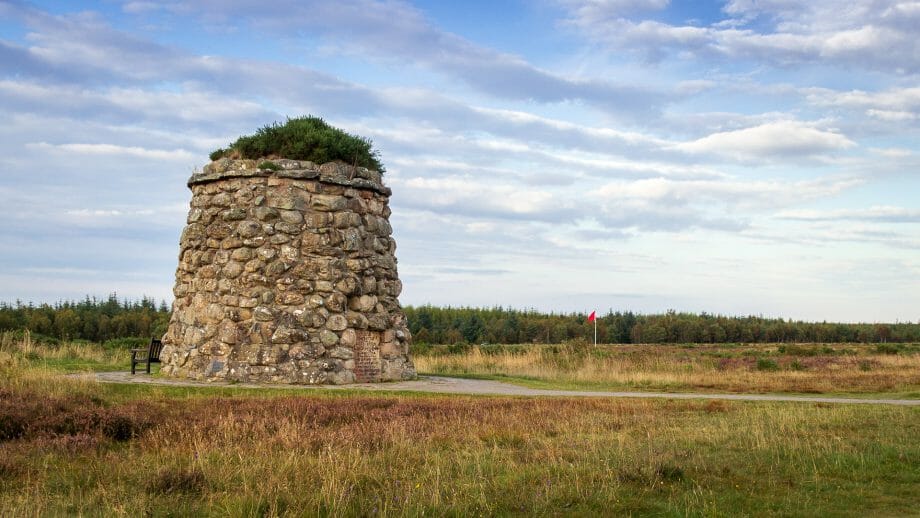
That’s why you need to see it:
at Culloden, rebellious clans lost to the British government. After this defeat, a time of suffering began in the Highlands. The place tells this tragic story.
More of it:
Another famous battlefield is Bannockburn – but there with a better outcome for Scotland.
Opening hours: High season Jun-Sep daily 09:00-17:00
Admission: Adults £11.00, 1 Adults & Children: £22.00
Imagine this image: On one side, the battle-ready men of the Scottish clans dressed in tartan. On the other, the redcoats of the British arms. The calm before the storm. Only bagpipe music wafting across the moor. Then. Cannons begin to thunder and after a while the Highlanders charge forward. Smoke, screams, blood. A good hour later, the Highlanders lie dying on the grass.
Culloden is a top Scottish attraction because it resurrects and conveys one of history’s tragic turning points. You too will be moved at the latest when you see the Memorial Stones to the Clans.
An interactive exhibition in the museum building will let you experience and understand the events surrounding the battle.
My Tip: A must for Outlander fans!
5 | Old Man of Storr
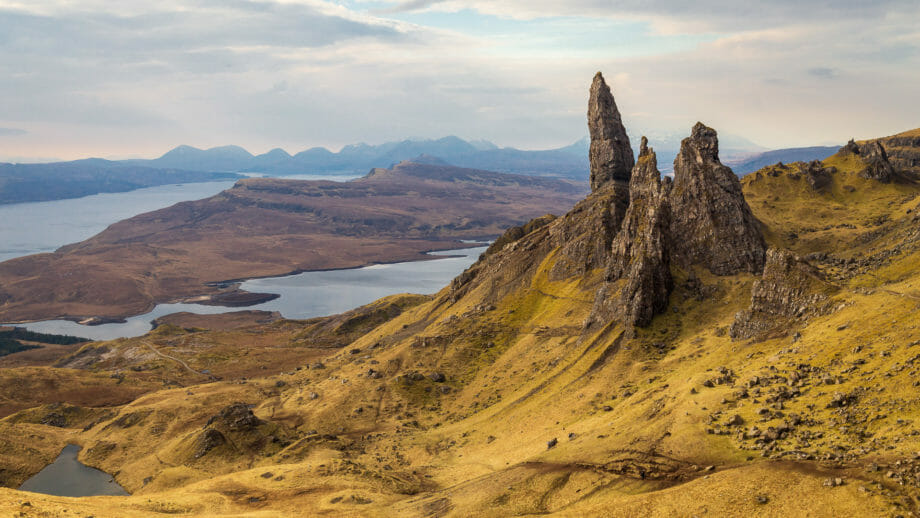
That’s why you have to see the Old Man of Storr:
The Old Man of Storr and the Quiraing impressively show the special rock formations on the Isle of Skye. Gigantic!
More of it:
The whole Isle of Skye – the Cuillin Mountains with the Fairy Pools or Neist Point.
A gigantic rock needle seems to balance effortlessly in the landscape. It is surrounded by rugged rock faces and round stones. In the background is a lake and further behind it the sea. What a backdrop! No wonder the Vikings used the Old Man as an important marker for sea voyages and that’s why they gave it a Norse name.
To experience this fantastic view for yourself, however, you’ll have to do a bit of hiking. Not too hard, don’t worry, but you should wear sturdy shoes. The tour starts directly at a car park below the Old Man and leads uphill on good gravel paths at first. At some point, however, it goes through a gate and from then on the path becomes more difficult.
If you want the view as seen in my photo, you need to take the path to the right at the Old Man of Storr. There is a hill that you climb. From the top you have the view.
My Tip: Avoid the usual rush hours. Come as early as possible or a little later in the day. Because then there are fewer visitors on site.
Actually, the entire Trotternish Peninsula of the Isle of Skye is one of the top attractions in Scotland. This is because the Trotternish Ridge, a special rock face, has formed here. This also includes the Quiraing. You can easily explore it by car. The way up is signposted. If you like hiking, there is also a longer tour that reveals many other beauties of the area. You can find out more here more.
6 | Edinburgh Castle
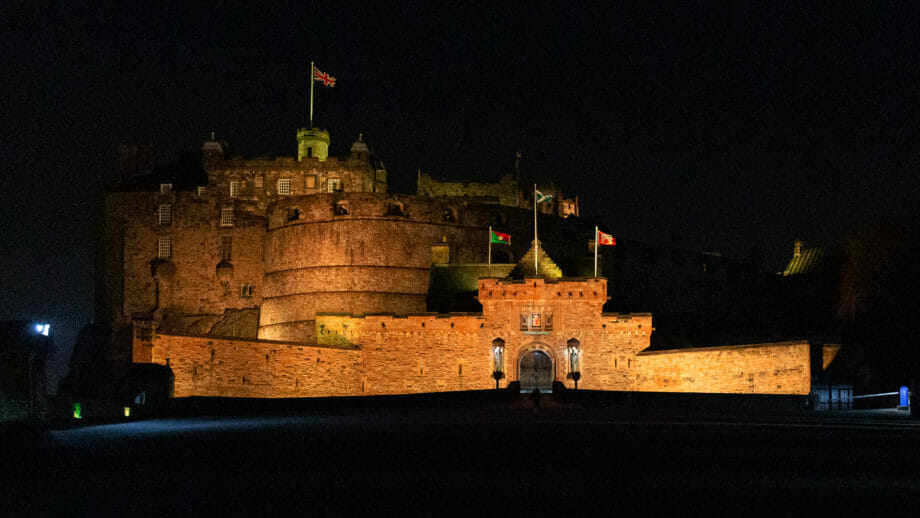
Why you must see Edinburgh Castle:
It is the centre and namesake of the Scottish capital. History and views make it one of Scotland’s most important attractions.
More of it:
Walk down the Royal Mile, visiting first St Giles Cathedral and then Holyrood Palace.
Opening hours: Summer Apr-Sep: daily 09:30-18:00 hrs.
Admission: approx. £16 adults, approx. £10 children
Violently perched on its huge rock, it looks down on the city. For over a thousand years, Edinburgh Castle has watched over the surrounding houses. Inside, visitors can easily get lost among all the history and impressive buildings. There are crown jewels to see here, but also the dungeons of prisoners of war from the Napoleonic wars.
Don’t be alarmed! At one o’clock noon the one o’clock canon is fired here. This was once used by the sailors in Leith harbour to align their ship’s chronometers. Of course, this is no longer important today, but the people of Edinburgh (and of course the tourists) did not want to give up their cherished tradition. The marching up of the soldier and the firing is admittedly one of the attractions at the castle today.
Either way: Take several hours if you want to visit the castle. It’s worth it in any case. The view of the city alone is worth it.
But beware: To avoid long queues, book your tickets online in any case. You can do that here (advertising link). Spontaneous visits have hardly been possible since Corona.
By the way, don’t be surprised: in the summer months there is a large grandstand on the forecourt of the castle. Because in the evenings, the famous Royal Edinburgh Military Tattoo takes place at Edinburgh Castle. A showcase of various music bands – mainly with bagpipes. More about that here.
7 | Calanais Stones (Callanish)
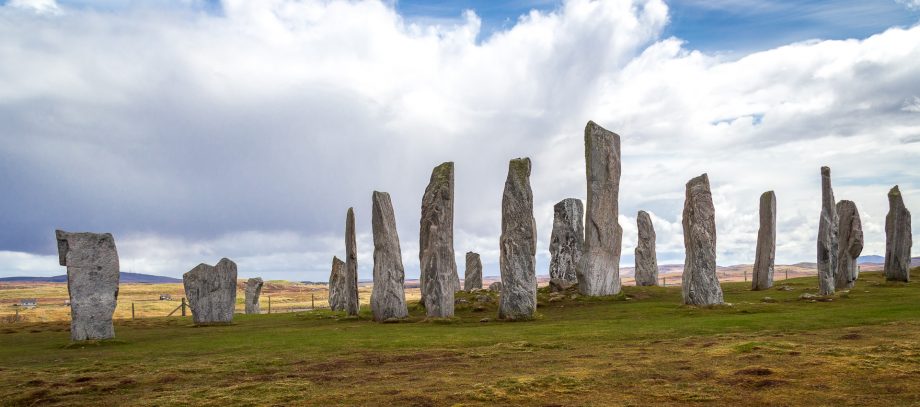
This is why you need to see Calanais:
It is the most beautiful stone circle in Scotland – if not the entire world.
More of it:
If you can’t make it to the Outer Hebrides, Orkney has the Ring of Brodgar, or near Culloden, where the Clava Cairns are located.
Opening hours: Stones always accessible
Admission: free
Throughout Scotland, stone circles are among the most beautiful attractions of all. Hardly any other country offers so many of them.
The king of the stone circles, however, is Calanais or spelt in English: Callanish. Actually, there are several stone circles to be found there on the Isle of Lewis and the most famous of them is not only circular in shape but has a sort of cross running through it. Walking among the huge and sometimes oddly shaped monoliths and soaking up the atmosphere is one of the most beautiful experiences in Scotland.
How the huge stones were brought here and what exactly they were used for is still not clear. Scientists assume that Calanais was used for observing celestial bodies. One theory is that the eastern arm of the cross that intersects the circle shows the full moon at the equinox in autumn. This was an important point between harvest and winter time. Other scholars think that the stones helped to anticipate the moment when the moon appears to dance on the nearby hills in the south. This happens every 18.6 years. The idea is that the people of that time believed the moon would then visit the earth.
Either way, the stones of Calanais always attract druids, hippies and other spiritual people on the solstice.
8 | Edradour Distillery
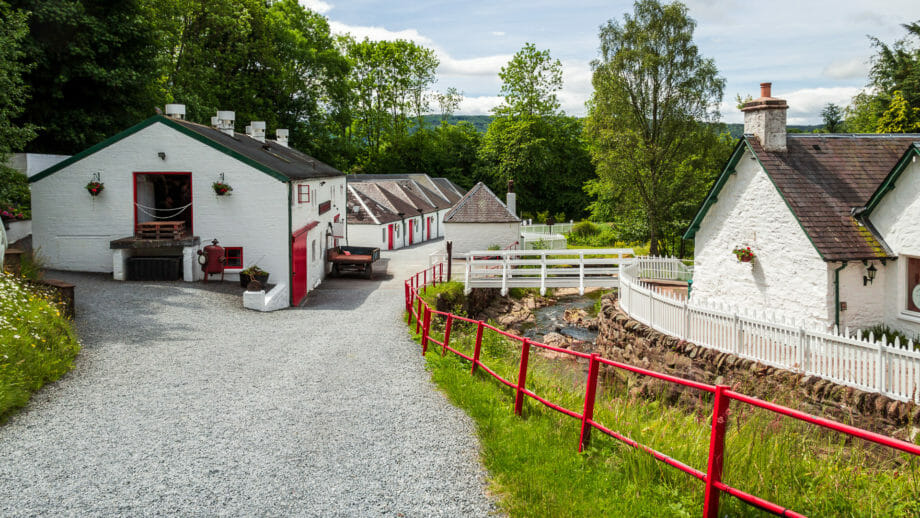
That’s why you have to see Edradour:
Centrally located, Edradour Distillery is a top attraction in Scotland thanks to its beautiful buildings by the picturesque stream.
More of it:
Scotland is full of distilleries worth visiting. If you want to get your fill, visit the whisky island of Islay, which currently has nine active distilleries.
Opening hours: Mon-Fri 10am-5pm, closed Sat/Sun (no access to the site after 4.30pm).
Admission: Tour with tasting £25
Whitewashed buildings with red doors duck along a gentle slope. A stream of clear water flows between them. Old equipment, barrels and discarded distilling utensils are everywhere. It’s hard to beat the Edradour Distillery near Pitlochry at the southern end of the Grampian Mountains. At least in terms of beauty. Edradour Distillery is also the smallest traditional whisky distillery in Scotland.
A tour here gives you a wonderful, up-close look at how whisky is made. From the malt to the cask, you see all the steps – and at the end, of course, you get to taste a sip. And if you want more, there is an excellent whisky bar right on the premises. You are not allowed to drive, though, as Scotland is very strict about that.
By the way, Edradour doesn’t only have their own production of Edradour and Ballechin whiskies (Ballechin is peated). They also store foreign casks in their warehouses.
As Edradour is small and popular, it is worth buying tickets in advance.
9 | Rosslyn Chapel
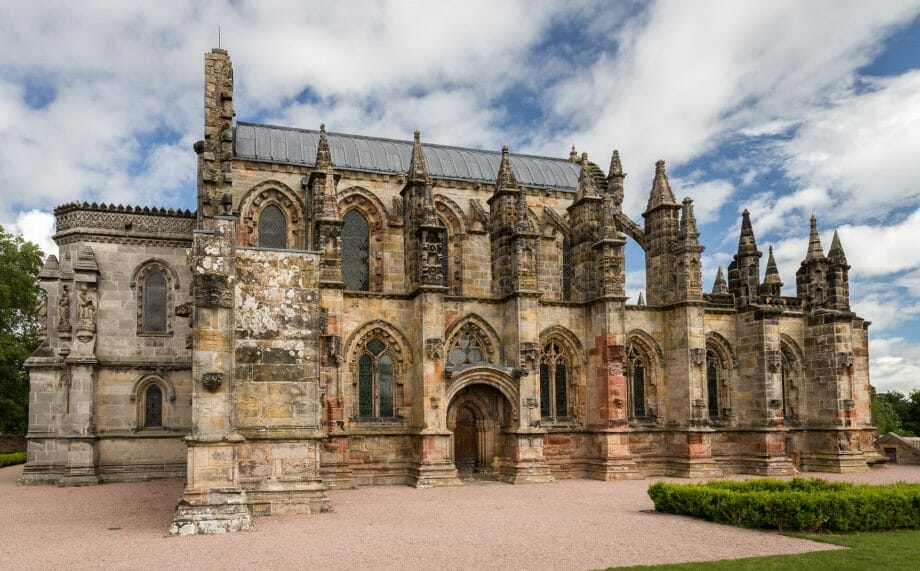
This is why you must see Rosslyn Chapel:
Simply the most beautiful and mysterious church in Scotland.
More of it:
In Edinburgh, the St Giles Cathedral with the Thistle Chapel. In Glasgow, St Mungo’s. Dunfermline Abbey, Melrose Abbey, Sweetheart Abbey, Jedburgh… Scotland is full of churches worth seeing.
Opening Hours:High Season Mon-Sat 09:30-18:00
Admission: Adults £9.50, children free with family
From the outside it’s a stunner – but wait until you see it from the inside. Rosslyn Chapel, just south of Edinburgh, is simply the most impressive church in Scotland. It’s not even particularly large, but the construction and ornamentation inside are unsurpassed in beauty.
In addition, there is enough history and stories surrounding this church – how could it be otherwise in Scotland – to give this attraction an air of mystery. Not least through a connection to the Knights Templar, which was established by the film “The Da Vinci Code – Sacrilege” – albeit purely fictitiously.
Another tale revolves around one of the stonemasons who laid out the fantastic interior of Rosslyn Chapel. He probably slew one of his apprentices because he was better than he was. The faces of both persons are immortalised in the decorations.
A little tip, moreover, is to walk to the nearby ruined Rosslyn Castle. It overlooks a deep gorge.
(Note: I can’t show you a photo of the inside because photography is forbidden there – and I abide by that.)
10 | Glen Coe
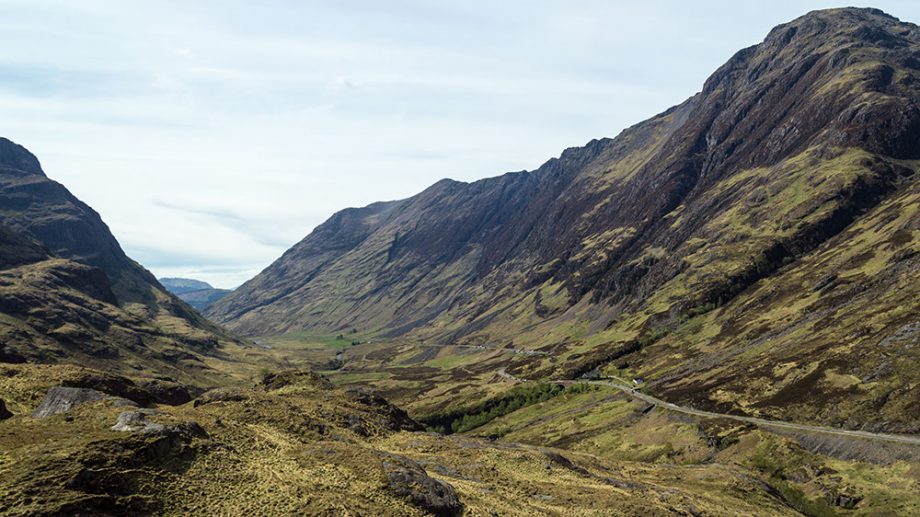
That’s why you have to see Glen Coe:
It is simply the glen in Scotland. With high mountains, deep valleys and tragic Scottish history.
More of it:
Glen Etive is a branch of Glen Cloe and also a top attraction. However, the road here is a little more difficult to drive. On the other hand, you pass the place where James Bond gazed into the valley with M. A famous photo by now that is often reenacted. A famous photo by now, which is often re-enacted.
Glen Coe belongs in the list of top attractions because it certainly offers one of the most beautiful settings – it can be driven through by car or, for those with more time, explored on foot, including proper mountain walks if desired.
Along the road there are always lookout car parks – you should also head for these, because away from these car parks it is now forbidden to stop in the valley. The viewpoints, however, are quite adequate. Coming from the south, Glen Coe begins with a climb, at the top a view of the mountains behind and Loch Tulla further down. Then it’s a bit through the southern foothills of Rannoch Moor and finally through the valley itself. Again, there are several opportunities to stop before heading back down. At the north-west end of Glen Coe there is a Visitor Centre where you can rest or visit an exhibition. The drive through the valley ends at Ballachulish.
Glen Coe, by the way, has a tragic history: it was here that members of the MacDonald clan were murdered by government troops, led by Campbells.
If you have seen the series Outlander: The beginning of the opening credits also show Glen Coe. And in Harry Potter, Hagrid’s hut is also here
11 | National Museum
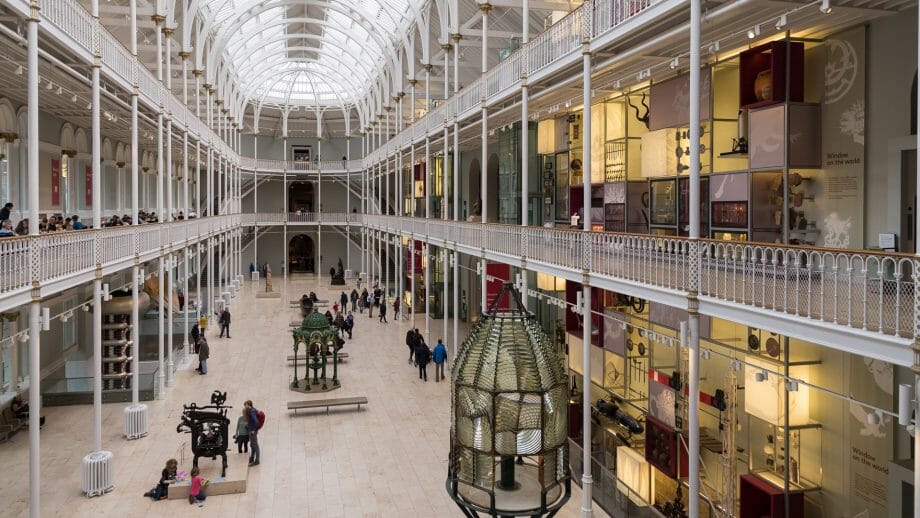
This is why you must see the National Museum:
All about Scotland in a modern and interactive museum. Also, one of the most beautiful attractions is the Victorian Hall.
More of it:
In Glasgow the Kelvingrove Museum, in Dundee the new V&A Dundee for Design. Both with great architecture and interesting exhibitions.
Opening hours:daily 10:00-17:00
Admission: free
Everything Scotland in one place. From early times with the first settlers to groundbreaking scientific developments like the cloned sheep Dolly. The National Museum in Edinburgh brings all this to you on several floors. Not only with artefacts on display, but also interactive and multimedia. Due to its size, you should take your time at the National Museum, at least a few hours. Optimal on rainy days in Edinburgh.
But it is not only the exhibitions that make the museum in the Scottish capital a top attraction; the building’s architecture is also magnificent. On the one hand, there is the Victorian main hall with its glazed arches, on the other hand, the new building also makes the hearts of lovers of younger architecture beat faster.
By the way, from the roof terrace you can get a good view over the rooftops to Edinburgh Castle. And the brilliant thing is that, as in many Scottish museums, admission is free here too.
12 | Stirling Castle
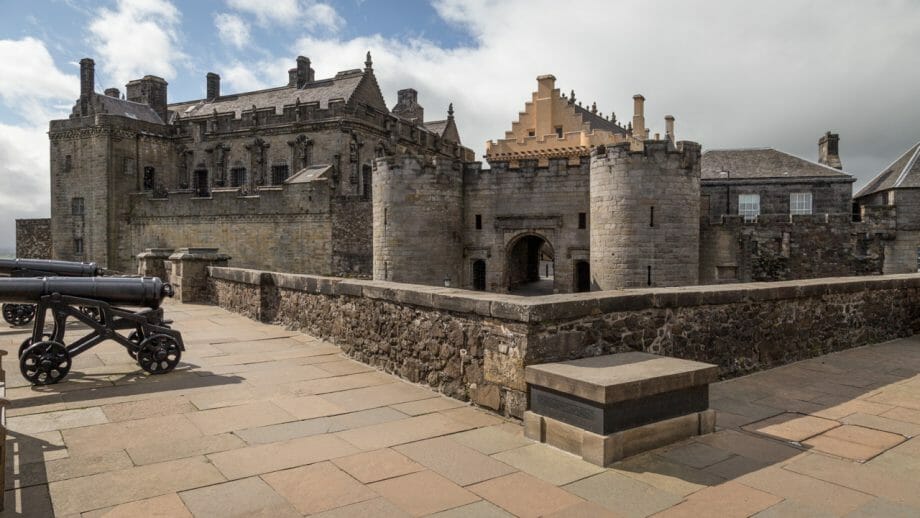
This is why you must see Stirling Castle:
The fated castle of the Scots. Huge and with history vividly portrayed.
More of it:
Edinburgh Castle is also very large and offers just as much history.
Opening Hours: High Season 09:30-18:00
Admission: Adults £16, Children £9.60
Whoever owned Stirling Castle could almost single-handedly control access to the north. No wonder, then, that the castle, perched on a high cliff, was built into a formidable bulwark. Because it was so important, it was repeatedly besieged and occupied by English and Scots in turns between the 12th and 14th centuries. Names like William Wallace and Robert the Bruce are closely interwoven with the fate of the castle.
Stirling Castle appears accordingly – a true fortress from the Middle Ages. Inside, however, it also shows the stately side. For the Stuart kings resided here time and again. This can be seen in the wonderful carvings and ornate wall hangings.
One other thing that makes Stirling Castle worth seeing is the views over the surrounding area and Stirling itself, which lies at its foot.
By the way, not far away is the Wallace Monument, which commemorates the Scottish independence hero. Also well worth seeing.
13 | Ring of Brodgar
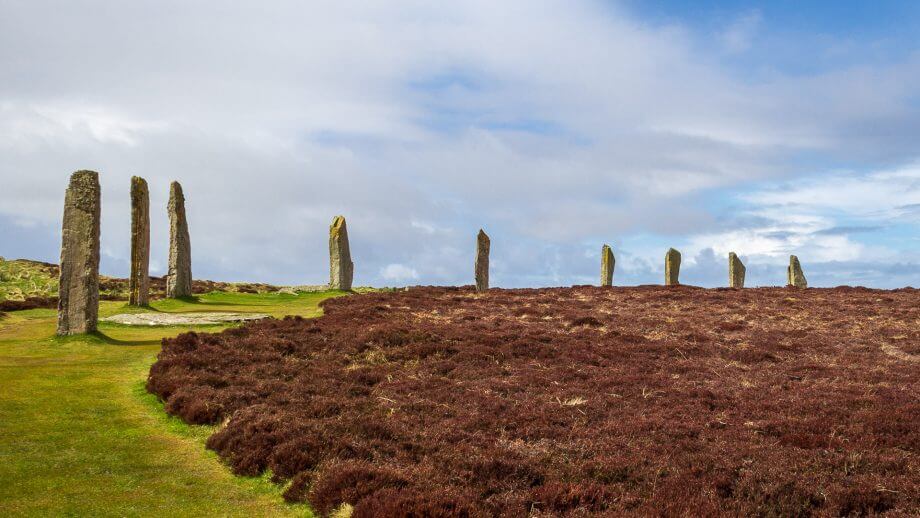
This is why you must see the Ring of Brodgar:
Third largest stone circle in Britain with monoliths up to five metres high. Part of the Neolithic Heart of Orkney.
More of the same:
Callanish in the Outer Hebrides or Clava Cairns near Culloden.
Opening hours: always accessible
Admission: free
You have to see this stone circle in the context of the whole environment: From the Standing Stones of Stennes and the nearby New Stone Age buildings, a processional route stretched along the narrow land connection “Ness of Brodgar” across to the Ring of Brodgar. Its diameter and huge stones form the awe-inspiring conclusion. One reason why it is one of the most important attractions in Scotland.
The stone circle, however, is one of the younger ones in the country. The flourishing Neolithic culture is said to have erected it here only about 2700 to 2000 BC. At that time with 60 stones, 21 of which are still standing today. What for and, above all, how, is still unclear, even though new finds in excavations are constantly consolidating the picture of the area.
While you’re here, be sure to visit the nearby Standing Stones of Stenness, the Mound of Maeshowe and the Stone Age town of Skara Brae. They are all part of the so-called “Neolithic Heart of Orkney”
14 | Necropolis in Glasgow
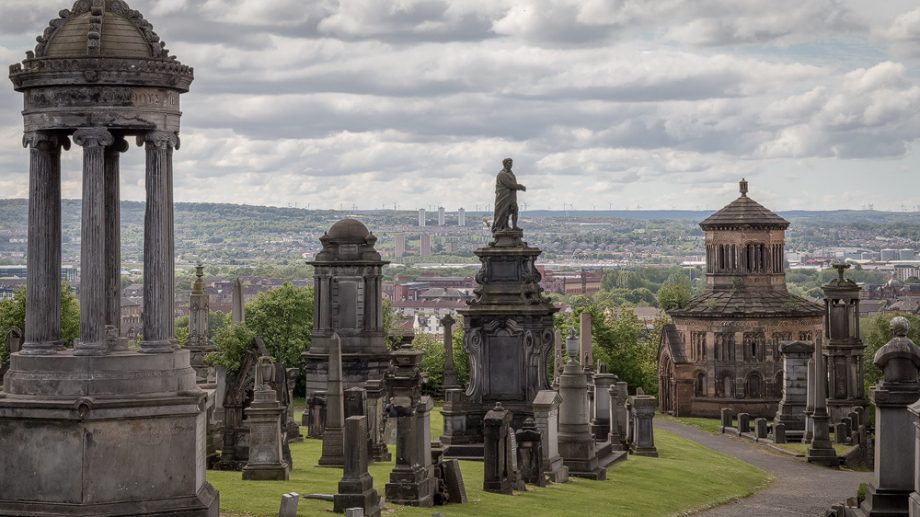
This is why you must see the Necropolis:
The most impressive cemetery in Scotland. Huge, peppered with ornate monuments and overlooking St Mungo’s Cathedral
More of it:
Greyfriars Kirkyard or Old Calton Burial Ground in Edinburgh.
Opening hours: last admission 4pm
Admission: free
This is big stuff: to get to the cemetery, you have to take the Bridge of Sighs over the hidden stream from the cathedral, walk towards the bricked-up entrance of the Catacombs and then climb the hill of the Mausoleums. The Glasgow Necropolis may not be familiar to many, but it is still one of Scotland’s must-see attractions.
The Glasgow Necropolis was modelled on the famous Paris Père Lachaise cemetery. It began to fill up at the beginning of the 19th century. Today, around 50,000 dead people lie there. Some very wealthy clients have had fancy mausoleums built here as their final resting places. In between, there are always statues of mourning angels or admonishing obelisks. In the background, the view over the city or of nearby St Mungo’s Cathedral.
By the way, the former entrance to the catacombs just at the end of the Bridge of Sighs was never used. It is true that the dead were supposed to be housed here to protect them from grave robbers. However, a change in the law deprived the thieves of their livelihood. And so the catacombs were never opened.
If you like graveyards, this is the best one in Scotland.
15 | Dunnottar Castle
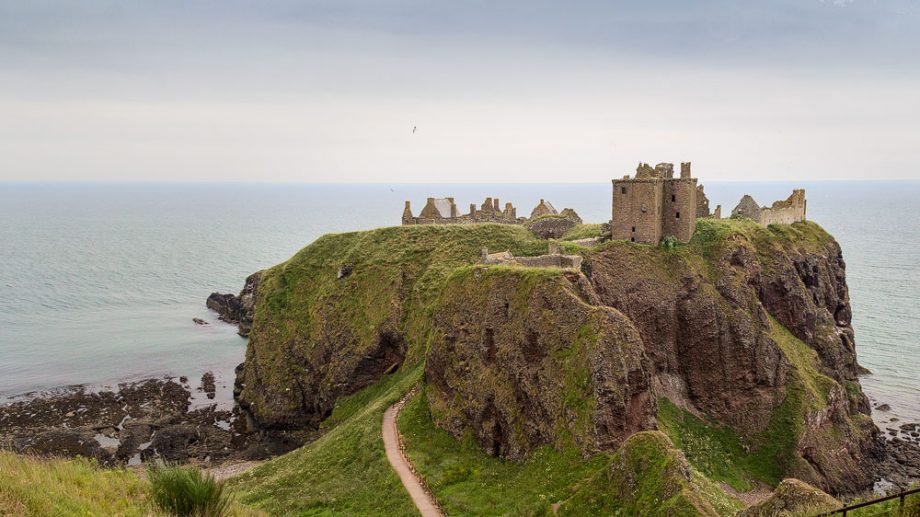
This is why you must see Dunnottar Castle:
A castle on a rock in front of the sea without a drawbridge. Impressive!
More of it:
Eilean Donan Castle in the Kyle of Lochalsh. Or Kisimul Castle in Barra/Outer Hebrides.
Opening hours: High season daily 09:00-18:00
Admission: Adults £8.00, children £4.00
If you’re driving up the east coast of Scotland, it’s definitely one of the top attractions. Dunnottar Castle is not particularly large and is only in ruins, but its location is unique. Perched on a high promontory, it looms menacingly over the sea. But there is no bridge or connection between you and the castle. So Dunnottar Castle seems to sit virtually alone on a huge cliff .
To reach it, you must first go all the way down and climb back up the other side. The inside of the castle is also worth seeing and of course there were Scottish atrocities here again. The English warlord Cromwell, for example, laid siege to the castle and shot it down because the imperial insignia were hidden inside – Crowmell was victorious, but still did not get them. Instead, so-called covenanters were later imprisoned in the dungeon. Many died here of hunger and despair.
So the location and history make Dunnottar Castle a real top attraction in Scotland.
16 | North-Highlands (North Coast 500)
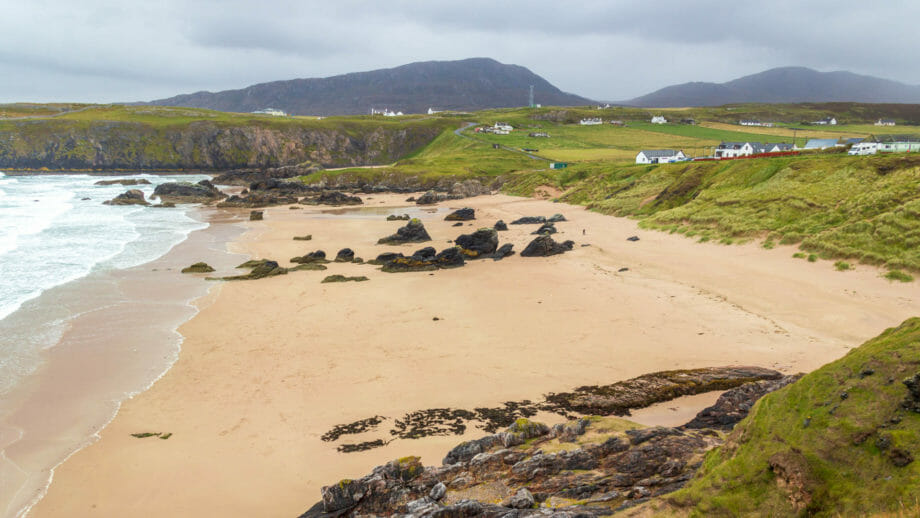
This is why you must see the Northern Highlands:
They are simply the essence of Scotland. Green hills, white beaches, rugged mountains, narrow roads …
More of it:
If you can’t make it that high north, the Isle of Skye is great. Otherwise Glen Coe or even the Pentland Hills in the south of Scotland.
An entire region as Scotland’s top attraction? Yes! Because the North Highlands doesn’t have THE ONE place you must see. Instead, there’s so much beauty in the north: the green hills you think of when you think of the Highlands. Sheep grazing on the peaty soil. Rugged mountains. Dreamy white sandy beaches and steep cliffs where the Atlantic breaks. Dark lakes, swift streams, rushing waterfalls over which salmon leap. Moors on which Highland cows stalk. Yellow gorse, green ferns, pink heather … in short: the Northern Highlands are pure force of nature!
There are, of course, individual attractions in between. Castle ruins like the photogenic Ardvreck Castle or complete castles, like the Castle of Mey. Another special place is Smoo Cave, a large cave on the north coast. The coastal town of Ullapool and its surroundings are also worth a visit.
To explore the North Highlands there is basically one road that goes up in the east, runs along the north coast and comes back down in the west. It is now known as the North Coast 500. Many use this route to drive through the area in a few days. However, many bed & breakfasts on the North Coast 500 have now decided to only rent for two nights or more. Visitors should stay longer and immerse themselves more in the landscape. And that’s what I recommend you do here too: enjoy the Highlands and take your time.
17 | Kelpies
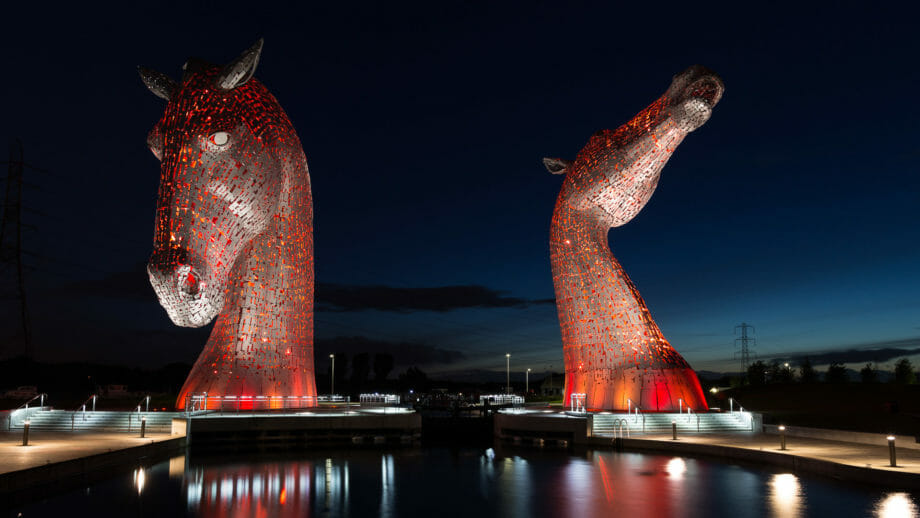
This is why you must see the Kelpies:
Two giant steel horse heads in a futuristic park setting with water. The Kelpies will amaze you
More of it:
By the same artist, a mermaid stands on the M80 at Cumbernauld. The nearby Falkirk Wheel is a marvel of engineering.
Opening hours:always accessible
Admission:free, tours around £5
Thirty metres of steel rears up gleaming as two giant horse heads. These are the Kelpies near Falkirk. Artist Andy Scott positioned them here at the end of a branch of the Forth and Clyde Canal to commemorate the workhorses that once pulled barges along the canal.
As it is, the Kelpies are one of Scotland’s top attractions. After all, they stand for a modern and technical country.
But if you want to really enjoy the Kelpies, come at dusk. Then the lights are switched on and the horses’ heads shine in gold, red and blue alternately. A magnificent spectacle!
18 | V&A Dundee
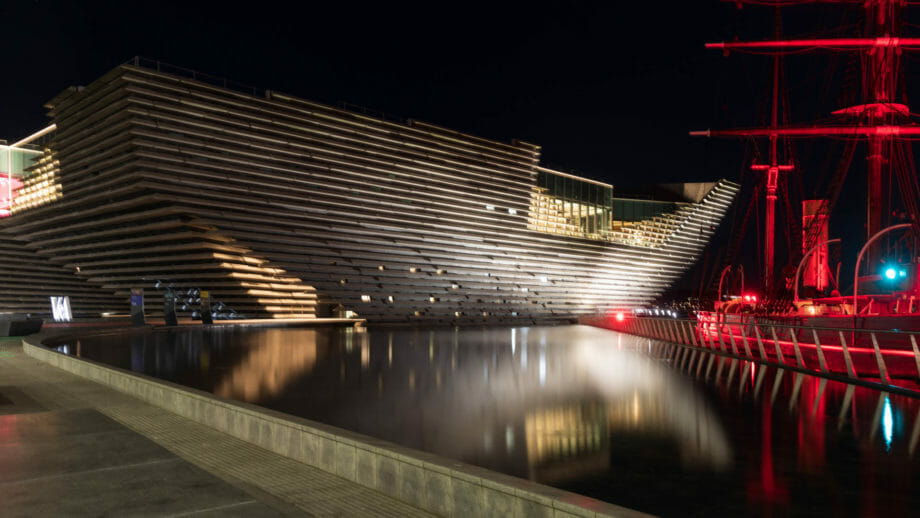
That’s why you have to see V&A Dundee:
On the outside, wow, on the inside! The new highlight of the city of Dundee that brings the beauty of Scottish design to life.
More of it
Kelvingrove in Glasgow has similar exhibitions, the Museum of Transport and the whole area around it on the Clyde also offers exciting new architecture.
Opening hours: Thu-Mun 10:00-17:00
Admission: free, only special exhibitions cost
Dundee is not the first tourist destination, certainly not for a first visit. However, the V&A Dundee is a top attraction for you if you like new architecture and design. Especially because the new building is ingeniously contrasted by the old polar expedition ship RSS Discovery next to it.
The “Victoria and Albert” Design Museum in Dundee was designed by Japanese Kengo Kuma and deliberately evokes a cliffside landscape.
Opened in 2018, it showcases importantmilestones of Scottish design.
19 | Dunrobin Castle
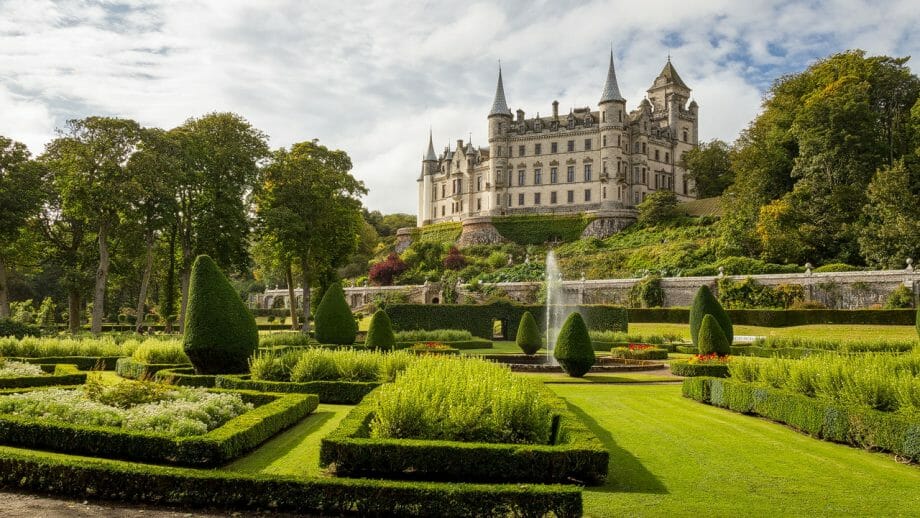
This is why you must see Dunrobin Castle:
A white fairytale castle with a dreamlike façade, cruel former owners and sharp-clawed birds of prey.
More of it:
Inveraray Castle isn’t quite as impressive on the outside, but it’s very opulent on the inside.
Opening hours: High season daily 10:00-17:00
Admission: Adults: £12.50, children £7.50
Located on the way up the east coast of the Highlands, Dunrobin Castle is one of Scotland’s top attractions. Built by the Sutherland family, it symbolises the pomp of wealthy families who brutally exploited and drove out the surrounding rural population in what became known as the Highland Clearances.
The Sutherlands had 189 rooms, some of which you can see today, complete with furniture. They had a garden modelled on Versailles laid out around the palace.
It’s best to see the palace from the garden, where the façade is most beautiful and the fountain and flowers in front of it do the rest. You can also take part in the worth seeing bird of prey flight show.
20 | St Kilda Archipelago
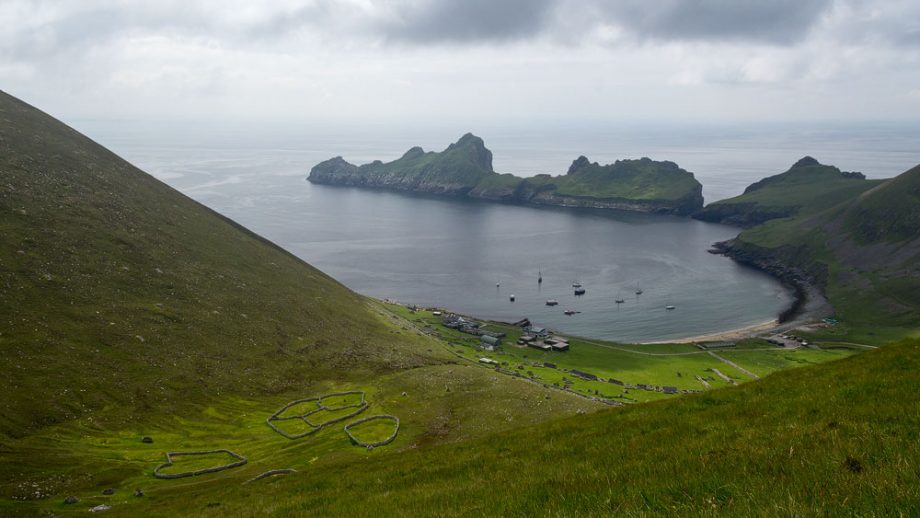
This is why you must see St Kilda:
A deserted archipelago with no people, but an incredible number of birds. The loneliness and hostility to life of this European outpost is impressive.
More of it:
The Isle of May in the Firth of Forth near Edinburgh is also home to many seabirds.
Opening times: Accessible by boat
Ticket: Adults £245, children £215
An entire group of islands as a point of interest? Yeah right! After all, St Kilda is also a UNESCO World Heritage Site. And rightly so. Because the nature of the islands is unique and at the same time terrifying. After all, St Kilda lies in the middle of the Atlantic, hours away from any mainland.
But that alone isn’t enough to spend around £250 on a day trip there, is it? Right. St Kilda also tells the story of the struggle of the people who once lived on these rocky islets. Who had erected “stone fridges” and “stone teeth” all over the island, who had designated the path in front of the few huts as the “main road” and who were deeply religious.
St Kilda also boasts one of the largest colonies of seabirds ever. When the sky above the boat turns dark due to gannets, gulls, puffins, torals and other feathered creatures.
The seclusion of St Kilda, the wildness and menace of nature and the incredible number of seabirds make St Kilda an unforgettable trip.